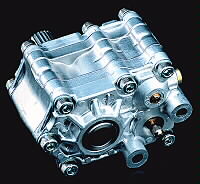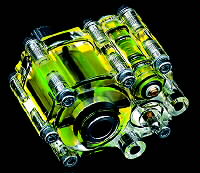Technical Overview: Suzuki TL1000 Rotary Shock
Rotary Dampers: The Coming Trend, Or Exotic Screen-Door Closer?
By John Olsen, Contributing Writer
 So what's up with Suzuki? This relatively quiet company, noted for occasional flashes of brilliance followed by long periods of technical sleepiness seems to have become a technological Godzilla. Recent examples include the dominant redo of their GSXR-750 and its smaller brother, the GSXR-600. And perhaps most astonishing of all, the TL-1000S with its upside-down forks and fuel injection. This Ducati 916 clone provides, at least on paper, most of the cutting-edge technology of the vaunted 916, but at 9/16ths the cost.
So what's up with Suzuki? This relatively quiet company, noted for occasional flashes of brilliance followed by long periods of technical sleepiness seems to have become a technological Godzilla. Recent examples include the dominant redo of their GSXR-750 and its smaller brother, the GSXR-600. And perhaps most astonishing of all, the TL-1000S with its upside-down forks and fuel injection. This Ducati 916 clone provides, at least on paper, most of the cutting-edge technology of the vaunted 916, but at 9/16ths the cost.
One technological feature that might help Suzuki compete with the all-conquering Ducatis is the novel rotary damper. Suzuki chose to separate the functions of springing and damping for this motorcycle. Why blaze a seemingly new path - a path that could be littered with unknown land-mines? Why not stick with the well-understood blessings of today's universal sport-bike rear suspension -- the linkage-actuated, coil-over-damper, single shock rear end? After all, the status quo ain't bad.
An obvious answer lies in a central problem of modern motorcycle design: Packaging. The latest school of race-bike design calls for much of a bike's weight to be carried by the front tire and for a short wheelbase that works with a steep steering head angle to give quick handling. Get enough weight on the front tire, and you gain several vital advantages: The bike can accelerate harder without wheelying, allowing steering corrections under acceleration. Also, the more weight the front tire carries, the harder it can be turned without exceeding reasonable slip angles. A longer wheelbase increases a bikes turning radius, meaning more lean angle is required to maintain cornering speed. Also, rider inputs or bike responses to bumps happen more slowly.
A longitudinal, 90-degree V-twin, like the TL, any twin Ducati, or the Honda VTR1000, presents a packaging challenge. Rock the engine forward, and you run into clearance problems between the front wheel and radiator. Rock it back, and the rear cylinder takes up valuable volume that could be used for the battery and the electrical system, or the shock absorber. The result is that 90-degree V-twin sport bikes tend toward the long side, with the TL and 916 shortest at 55.7 and 55.6 inches, respectively, and the VTR and the 900SS at 56.3 and 56.4. The VTR tries to minimize the wheelbase penalty by running twin side-mounted radiators, allowing the engine to come as far toward the front tire as fork travel and flex allow.
Suzuki achieves a relatively forward weight bias and a moderately short wheelbase by clever engine and head design (the cam drives and cam layouts in the heads are specifically designed to permit the engine to live closer to the front wheel). Also, placing miscellaneous stuff in the space where Ducatis and Honda place their rear shocks allows for a tighter, trimmer package.
So where does the shock go? Suzuki, teaming with Kayaba, opted for a solution that has actually been used before in huge numbers -- the lever-actuated, rotary-acting, hydraulic shock. While many people will credit Suzuki for inventing this design, a damper of similar concept, the Houdaille, has been used on vehicles ranging from sports cars to trucks since the early days of damped suspension.
Suzuki's rotary shock gives them some advantages in addition to a shorter wheelbase. One is heat dissipation. Perhaps the major enemy of any damper design is heat build-up. Damping is just conversion of some of the mechanical energy generated by the motorcycle bouncing on its springs into heat energy. Since hydraulic fluids and rubber seals can't operate at high temperatures, this heat has to be dissipated, or the damper will work poorly.
The TL's aluminum damper body has more mass than a tubular shock, and this mass in itself will absorb heat from the damping fluid until it is just as hot as the fluid. In fact, early testers report that the damper stays cool to the touch, even during hard track sessions, something you can't claim for the typical tube shock design.
Relative motion between the moving parts in this damper consists, obviously, of rotation. Two good things happen with rotational, rather than telescoping, motion: Rotating joints between the damper body and shaft are easy to seal and keep clean, and you can use rolling-element bearings rather than bushings between the two parts. Both changes make reduced friction likely in the TL's damper, which has no exposed sliding surfaces. In contrast, conventional tubular shocks have a potentially dirty shaft sliding into and out of a seal, and such shocks are subject to bushing side loads. Both sources of friction increase the force needed to get the suspension moving.
 However, rotary dampers still employ sliding seals to separate the working volumes inside the damper. Two rubber-tipped metal vanes mounted to the rotor seal against the inner diameter of the damping body, trapping damping fluid between themselves and another two vanes fixed to the damper body's inner diameter. These vanes, in turn, must seal against the rotor's outer surface. As oil is compressed by the two rotor vanes, it travels through ports to either the rebound or compression valve and washer stack. The damping orifices and valving work exactly the same way they do in a conventional shock. A small, pressurized gas chamber ahead of the rotor is only there to compensate for the thermal expansion of the oil as it heats up, as there is no rod volume to accommodate as on a telescopic damper.
However, rotary dampers still employ sliding seals to separate the working volumes inside the damper. Two rubber-tipped metal vanes mounted to the rotor seal against the inner diameter of the damping body, trapping damping fluid between themselves and another two vanes fixed to the damper body's inner diameter. These vanes, in turn, must seal against the rotor's outer surface. As oil is compressed by the two rotor vanes, it travels through ports to either the rebound or compression valve and washer stack. The damping orifices and valving work exactly the same way they do in a conventional shock. A small, pressurized gas chamber ahead of the rotor is only there to compensate for the thermal expansion of the oil as it heats up, as there is no rod volume to accommodate as on a telescopic damper.
It is in the sealing that a potential dark side of the rotary hydraulic damper lurks. Any leaks mean a loss of damping, just as they do in any hydraulic shock. All of the vane seals have to seal a rectangular area, and this is tougher than the annular area that a typical telescopic shock seal must cope with. Why? The rectangular area between the rotor and damper body has sharp corners that want to warp or bend, especially when the movement is in both directions. It is likely the assembly precision necessary to get the vanes to seal perfectly is what caused Suzuki and Kayaba to declare the damper non-serviceable.
Since the sizes and volumes of the working chambers aren't limited by the size of a coil spring's inner diameter, the TL's damper can pump a lot of oil. This high flow rate could be taken advantage of to make precise and fine damping adjustments easier than with the more-constrained tube shock design. In fact, the damping adjustment screws (compression on one side, rebound on the other) are quite easy to get at, with no remote mechanisms required.
As the damper is actuated by its own linkage, it can be set up for different rate rise than the spring. For instance, it would be possible to design the linkage so that the spring got stronger and the damper weaker as the suspension reached full bounce travel, or vice versa. This example is patently silly, but the separate linkage does offer unique (and potentially bewildering) tuning options if a serious tuner is willing and able to design and build new links.
Suzuki has given the TL's damper a fairly flat-rate linkage so that damper strength stays fairly consistent with travel, while the spring has a progressive, or rising-rate design.
The biggest downside to the rotary damping concept might just be the total lack of a fall-back position. Think about it: If you don't like the Kayaba or Showa shock in your traditionally-damped bike, you can choose from a number of alternative shocks from reputable aftermarket vendors. If you dislike the TL's rotary unit, you're up the creek without a damper -- at least until the aftermarket starts producing shocks for the TL.
Suzuki has gone out on a limb with this design, but for some good reasons. We hope the limb turns out to be a strong one, for there are some clear advantages to the rotary design, and they help make Suzuki's TL the stunning bike that it is.